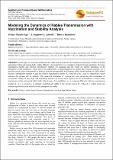Modeling the Dynamics of Rabies Transmission with Vaccination and Stability Analysis

View/
Date
2015-10-09Author
Ega, Tesfaye Tadesse
Luboobi, Livingstone
Kuznetsov, Dmitry
Metadata
Show full item recordAbstract
In this paper we formulate a deterministic mathematical model for the transmission dynamics of rabies in human
and animal within and around Addis Ababa, Ethiopia. Our model involves vaccination program for dog population. The basic
reproduction number and effective reproduction numbers are computed and the results are entirely depending on the
parameters of dog population, which shows the responsibility of dog population for human and livestock infection. For a
specified set of values of parameters as deduced from the data provided by Ethiopian Public Health Institute of Addis Ababa,
the basic reproduction number 0 R and the effective reproduction number e R works out to be 2 and 1.6 respectively, which
indicates the disease will be endemic. The numerical simulation of reproduction ratio shows that the combination of
vaccination, culling of stray dogs and controlling annual crop of new born puppies are the best method to control rabies
transmission within and around Adds Ababa. The disease - free equilibrium 0 e is computed. When the effective reproduction
number 1 e R < it is proved to be globally asymptotically stable in the feasible region F . When 1 e R > there exists one
endemic equilibrium point which is locally asymptotically stable.
